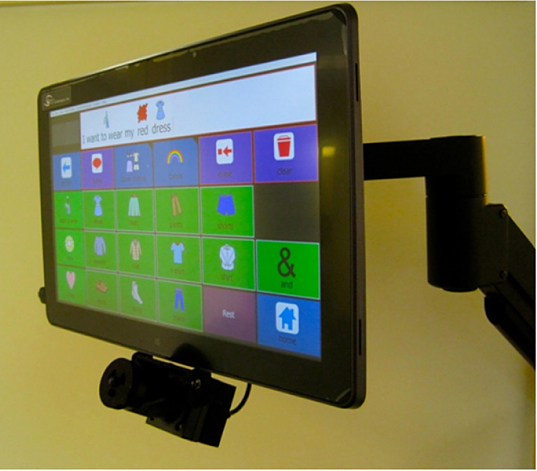NuShield and LC Technologies Team Up to Help Patients Communicate Using Eye Tracking Technology on Tablets

Fairfax, Virginia based eye tracking software developer LC Technologies, and screen protector and glare-elimination technology specialists NuShield, Inc. of Newtown, Pennsylvania ate teaming up to bring communication mobility to disabled patients who are unable to communicate via speech or hand motion.
Eye tracking is the field of monitoring what people do with their eyes — observing what people choose to look at, how their eyes move, how their visual activities behave. Eye trackers are instruments that measure eye behavior, ie: the directions that our eyes are pointed and predict our gaze points, i.e. the locations of the objects in space that we look at.
Many modern eye trackers are based on video cameras that observe our eyes and produce high-resolution images of our irises, pupils, and scleras. Light emitting diodes illuminate the eyes, and these LEDs produce reflections off the corneal surfaces to provide critical geometric information about the orientation of the eyeball.
Behind the cameras that capture images of the eyes, the essential element of the eye tracker is the software image processing function that identifies the eyes within the images, measures geometric features of eye elements, and computes the eyes’ spatial positions and orientations. The eye tracker projects the special location of the eye’s gaze points. If a person is looking at a computer screen, for example, the gaze point may be expressed in x,y screen coordinates.
Until recently, bulky LCD monitors with matte screen finish had to be used for eye tracking applications because tablets, although having the advantages of being light and mobile, have glossy screen surfaces that produce glare and disrupt proper eye tracking function. However, considering it an imperative that tablets be adapted to provide patient mobility and ease of operation. LC Technologies reached out to NuShield for a solution to the problem.
Once NuShield’s proprietary Triple A film was installed on the tablet display surface, glare was eliminated, allowing users to operate the system comfortably. The Triple A film provides anti-glare, anti-fingerprint and anti-microbial protection, making an the ideal choice for use in a variety of environments, including patient care.
LC Technologies can currently load its software on numerous platforms such as the Asus and Microsoft tablets, which only weigh a few pounds, better enabling users with disabilities to communicate and interact with the world. The company’s Eyegaze Edge software is an eye-operated communications system incorporating a camera that follows the user’s eye movement, enabling him or her to type, “speak”, turn on a television, or access the Internet by looking at cells displayed on the screen.

The Eyegaze tracking technology provides a lifeline for people with motor disabilities such as ALS (Lou Gehrig’s disease), brain injury, cerebral palsy, multiple sclerosis, muscular dystrophy, spinal cord injury, stroke, spinal muscular atrophy, and brainstem stroke.
NuShield is a woman-owned business established in 1998. Its Triple A antiglare, antimicrobial and anti-fingerprint film provides excellent screen visibility along with protection against germ growth on electronic displays — an especially important feature for screens touched by multiple users. The film’s antiglare property diffuses glare from overhead or window light and allows users to interact with the display. The antiglare property also prevents the transmission and reflection of 99% UVB ultraviolet light from reaching the user’s eyes, a factor in eyestrain and computer vision syndrome.
The film uses a low-tack adhesive to attach to the screen surface and is easy to remove, clean and re-insert, does not create air bubbles or leave residue on the screen, and can be cleaned with disinfectants and solvents while its own anti-microbial property remains to continually inhibit the growth of germs on the film surface. As a bonus, it also hides unsightly fingerprints, and delivers long-lasting scratch resistance, lower haze and improved anti-Newton ring optical performance.
NuShield’s antiglare, DayVue (antireflective) and Triple A (antiglare-antimicrobial-anti fingerprint) film can fit devices with screens up to 80 inch diagonal. NuShield films are only about 0.005″ thick, yet work with resistive and projected capacitive touch screens (most touch screens are these types).
NuShield DayVue antireflective film cancels reflected light in the same manner as noise cancelling headphones cancel ambient noise.
Protection for displays used outdoors have special challenges, being highly prone to glare from the sun and reflections from other surfaces. To minimize this impact on the display, manufacturers may treat their screens with antireflective coatings consisting of thin layers designed to cancel out reflected light while allowing transmitted light through. They create an internal reflective surface that is 1/4 wavelength thick. These two surfaces allow light to be 180 out of phase with light reflecting off the top surface, destructively interfering and cancelling out the light intensity. NuShield DayVue antireflective (AR) film replicates the AR coating on your display, protects it from damage, and will upgrade a screen that does not have AR capabilities for better performance.
The latest version of this film has several top layers with carefully chosen index of refraction minimizing the blue end of the spectrum.
This structure creates greatly diminished reflectance over most of the visible light spectrum, allowing the screen to be seen clearly even with polarized sunglasses, and largely eliminating blue-violet banding.
For devices with touch screen application the films antimicrobial properties have been specifically formulated to eliminate contamination created by multiple users in environments such as those in hospitals and other medical facilities where the display normally provides a breeding ground for germs.
NuShield cites laboratory tests using colon bacillus and Staphylococcus aureus bacteria in which the Triple A film’s antimicrobial coating has shown a reduction rate of 99% of these germs over a 24 hour period. The film’s inorganic antibacterial coating is claimed to have an excellent antibacterial spectrum as well as heat and solvent resistance.
Sources:
LC Technologies
NuShield, Inc.
Image Credits:
LC Technologies
NuShield, Inc.






